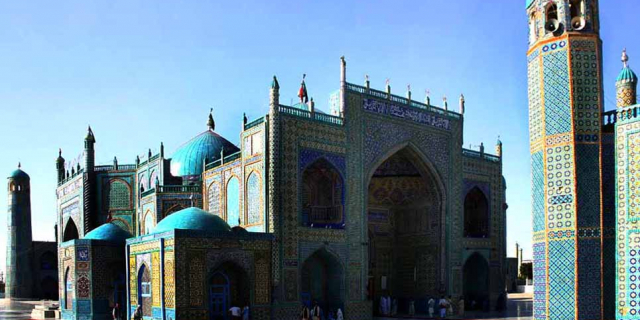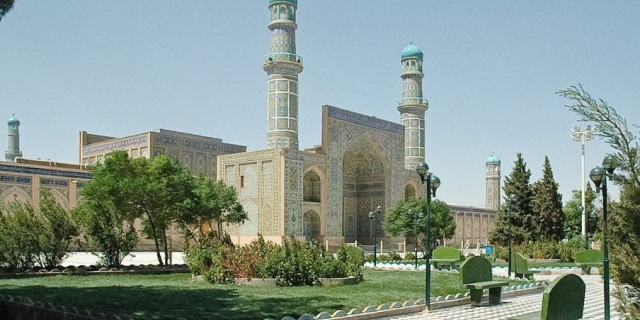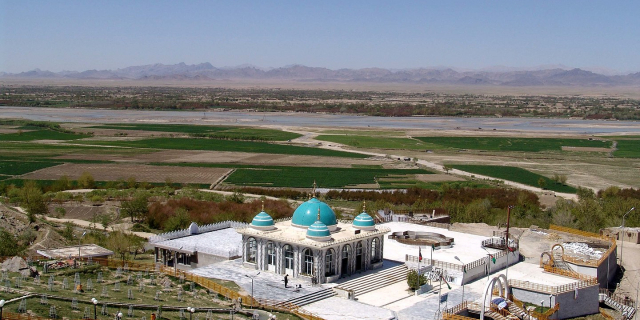Minaret of Jam
The Minaret of Jam is a UNESCO World Heritage Site in western Afghanistan. It is located in a remote and nearly inaccessible region of the Shahrak District, Ghor Province, next to the Hari River. The 62 m (203 ft) or 65 m (213 ft) high minaret was built c. 1190 entirely of baked bricks and is famous for its intricate brick, stucco and glazed tile decoration, which consists of alternating bands of kufic and naskhi calligraphy, geometric patterns, and verses from the Qur'an. Since 2002, the minaret has remained on the list of World Heritage in Danger, under serious threat of erosion, and has not been actively preserved. In 2014, the BBC reported that the tower was in imminent danger of collapse.
In 2020, the Minaret of Jam was listed among cultural heritage sites of the Islamic world by the Islamic World Educational, Scientific and Cultural Organization (ICESCO). According to the Afghan Ministry of Foreign Affairs (MoFA), the Minar...Read more
The Minaret of Jam is a UNESCO World Heritage Site in western Afghanistan. It is located in a remote and nearly inaccessible region of the Shahrak District, Ghor Province, next to the Hari River. The 62 m (203 ft) or 65 m (213 ft) high minaret was built c. 1190 entirely of baked bricks and is famous for its intricate brick, stucco and glazed tile decoration, which consists of alternating bands of kufic and naskhi calligraphy, geometric patterns, and verses from the Qur'an. Since 2002, the minaret has remained on the list of World Heritage in Danger, under serious threat of erosion, and has not been actively preserved. In 2014, the BBC reported that the tower was in imminent danger of collapse.
In 2020, the Minaret of Jam was listed among cultural heritage sites of the Islamic world by the Islamic World Educational, Scientific and Cultural Organization (ICESCO). According to the Afghan Ministry of Foreign Affairs (MoFA), the Minaret of Jam is Afghanistan's first cultural heritage site to be listed by ICESCO.
 Jam minaret
Jam minaret Timurid conqueror Babur advances through Jam and the mountains to Kabul.
Timurid conqueror Babur advances through Jam and the mountains to Kabul.During the 12th and 13th century, the Ghurids controlled what is now Afghanistan, but also parts of eastern Iran, Central Asia, Northern India and parts of Pakistan.[1]
The Arabic inscription dating the minaret is unclear – it could read 1193/4 or 1174/5 when converted to Gregorian dates. It could thus commemorate the victory of the Ghurid sultan Ghiyas ud-Din over the Ghaznevids in 1186 in Lahore.[2] However, Dr. Ralph Pinder-Wilson, a British Archeologist and Director of the British Institute of Afghan Studies in the 1970s, wrote a major study of the Minarets of Jam and Ghazni in which he expressed his belief that the minaret was built to commemorate the victory of Mu'izz ad-Din, Ghiyath ud-Din's brother, over Prithviraj Chauhan. This victory allowed Islam to spread into the northern Indian subcontinent.[2] Pinder-Wilson believed that the minaret was built in the style of the time, which included a tradition of early Islamic victory towers proclaiming the conquering power of Islam.[3]
It is assumed that the Minaret was attached to the Friday Mosque of Firozkoh, which the Ghurid chronicler Abu 'Ubayd al-Juzjani states was washed away in a flash flood, some time before the Mongol sieges in the early 13th century.[citation needed] Work at Jam by the Minaret of Jam Archaeological Project has found evidence of a large courtyard building beside the minaret, and evidence of river sediments on top of the baked-brick paving.[4]
The Ghurid Empire's glory waned after the death of Ghiyath ud-Din in 1202, as it was forced to cede territory to the Khwarezm Empire. Juzjani states that Firuzkuh was destroyed by the Mongols in 1222.[4]
The Minaret was little known outside of Afghanistan until Sir Thomas Holdich reported it in 1886 while working for the Afghan Boundary Commission. It did not come to world attention, however, until 1957 through the work of the French archaeologists André Maricq[5] and Gaston Wiet. Later, Werner Herberg conducted limited surveys around the site in the 1970s, and Ralph Pinder-Wilson completed his major study of the site in the same decade, before the Soviet invasion of 1979 once again cut off outside access.
2022 earthquakeOn January 17, 2022, an earthquake struck western Afghanistan, killing 28 people. The earthquake caused bricks to fall from the tower and it is now at an even further risk of collapsing.[6]




























Add new comment